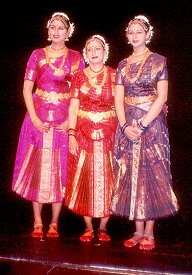 |
 |
The eyes have it
July 23, 2004 The launch of Sankara Eye Foundation Europe at London's Cochrane Theatre was a balanced affair, with an hour of speeches, ceremony and promotional films being followed by an equally lengthy but altogether more stimulating Bharatanatyam performance. Established 'with the blessings of the Shankaracharyas of Kanchi' in 1977, the Coimbatore-based Foundation has achieved much. Since 1998 funds have been boosted considerably by contributions from NRIs to SEF USA. Therefore SEF Europe is a logical next step. |
 |
| It is no criticism
of the Sankara Eye Foundation and others to suggest that they are doing
the work which politicians have neglected. If we can afford cars and televisions
individually, we can afford schools and hospitals collectively.
The Divine Vision is choreographed by Padma Murali to recorded music and English narration. Following a sung invocation to Ganesha, Padma's training in the Pandanallur style is evident in the subtlety of her performance, her gestures being flowing and gentle rather than dramatic. The audience is drawn into her narrative, which benefits from a believable, naturalistic use of facial expression. Greater excitement
is generated by the arrival of Padma's daughter Janani and daughter-in-law
Poornima Kaushik. Their synchronicity approaches perfection.
The visual dialogue is intricate and absorbing. Janani Murali, in particular, is a wonderfully expressive Brahma. Her athletic poise and expansive use of her whole body is an object lesson in the form. Poornima, too, gives a confident and spirited performance. By now the programme has settled into a pattern of Padma Murali's mimed narration followed by the junior artists' lively enactment. Poornima and Janani make a dynamic Shiva and Parvati, in a depiction of the divine couple's marriage involving some intricate rhythmic work. The hunter Kanappan's extraordinary devotion to Shiva provides a tale of obvious relevance here. Praying at a temple, Kanappan notices that one of Shiva's eyes is bleeding. He substitutes an eye of his own. Then, seeing Shiva's other eye similarly afflicted, Kanappan marks the spot with his foot before donating his remaining eye to the deity. Padma Murali's involved narrative detail contrasts with a curt, noncommittal performance from Poornima. The closing ensemble piece is a little chaotic at first. In a marked change of style, with contemporary fusion music to match, the trio attempts a little blackout shadow play with a sheet of cloth and four diyas. This is incoherent, but it does lead to some much better short pieces on losing and regaining sight. There is an odd juxtaposition of musical styles (including Tamil film song). The celebratory finish is nonetheless uplifting, before a final 'Obeisance to Shankaracharya'. All three artists worked very hard to present a varied and joyous production. Poornima Kaushik's sense of fun was conveyed to the audience while Janani Murali's technique is of the highest quality. All credit to Padma Murali for her own '20-20' choreography. With thanks to Rebecca Peltenberg. www.sankaraeye.com Richard Turner, the Editor of veena Indian Arts Review |